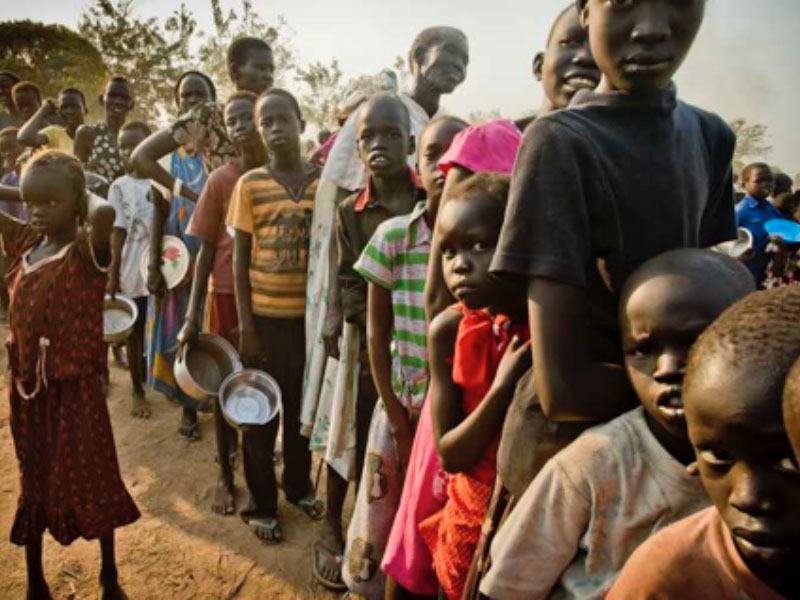The Food and Agricultural Organisation (FAO) and the World Food Programme (WFP) have jointly issued a statement warning that acute food insecurity is set to increase in magnitude and severity in 18 hunger “Hotspots” countries of the world including Nigeria.
This new United Nations (UN) early warning report spotlighted the urgent need of assistance to prevent famine in Gaza and the Sudan, and further deterioration in the devastating hunger crises in Haiti, Mali, and South Sudan.
“It also warns of the lingering impact of El Niño and the looming threat of La Niña that risks bringing further climate extremes that could upend lives and livelihoods” in Nigeria and other countries.
“The report found that many hotspots face growing hunger crises and highlights the worrying multiplier effect that simultaneous and overlapping shocks are having on acute food insecurity.”
It went on to say that “conflict, climate extremes, and economic shocks continue to drive vulnerable households into food crises.”
Furthermore, the report warns that 2023 is likely to mark the first year since 2010 in which humanitarian funding has declined compared to the previous year, but it still represents the second highest funding level ever for humanitarian assistance.
“The daunting prospects highlighted in this report should serve as a wake-up call to all of us. We need to spearhead the shift from responding to crises after they occur to more proactive anticipatory approaches, prevention and resilience building to help vulnerable communities cope with upcoming shocks.
“Acting ahead of crises can save lives, reduce food shortages and protect livelihoods at a much lower cost than a not timely humanitarian response,” FAO Director-General QU Dongyu said.
“Once a famine is declared, it is too late – many people will have already starved to death. In Somalia in 2011, half of the quarter of a million people who died of hunger perished before famine was officially declared.
“The world failed to heed the warnings at the time and the repercussions were catastrophic. We must learn the lesson and act now to stop these hotspots from igniting a firestorm of hunger,” said Cindy McCain, WFP Executive Director. “We have proven solutions to stop these crises in their tracks, but we need the resources and the political will to implement them at scale before more lives are lost.”
The report calls for urgent humanitarian action to save lives and livelihoods and prevent starvation and death in 18 hotspots – comprising a total of 17 countries and one regional cluster of four countries (drought-affected Malawi, Mozambique, Zambia and Zimbabwe) – where acute hunger is at a high risk of worsening from June to October 2024.
It said that the ongoing conflict in Palestine is expected to further aggravate already catastrophic levels of acute hunger, with starvation and death already taking place, alongside the unprecedented death toll, widespread destruction and displacement of nearly the total population of the Gaza Strip – the report warns. In mid-March 2024, famine was projected to occur by the end of May in the two northern governorates of the Gaza Strip, unless hostilities ended, full access was granted to humanitarian agencies, and essential services were restored.
“Over one million people – half the population of Gaza – are expected to face death and starvation (IPC Phase 5) by mid-July. The report also warns of broader regional ramifications of the crisis, which risk exacerbating the already high food security needs in Lebanon and the Syrian Arab Republic.
“This edition of the report warns that La Niña conditions are expected to prevail between August 2024 and February 2025, significantly influencing rainfall distribution and temperatures.
“The shift in climate could have major implications for several hotspots, including risk of floods in parts of South Sudan, Somalia, Ethiopia, Haiti, Chad, Mali and Nigeria, as well as the Sudan.
“Conflict is the primary driver of hunger in all these areas. All hotspots of the highest concern have communities facing or projected to face starvation, or are at risk of sliding towards catastrophic conditions, given they have already emergency levels of food insecurity and are facing severe aggravating factors.
Chad, the Democratic Republic of Congo, Myanmar, the Syrian Arab Republic and Yemen are hotspots of very high concern, with a large number of people facing critical acute food insecurity, coupled with worsening drivers that are expected to further intensify life-threatening conditions in the coming months.
“Since the previous edition of the Hunger Hotspots report (October 2023), the Central African Republic, Lebanon, Mozambique, Myanmar, Nigeria, Sierra Leone and Zambia have joined Burkina Faso, Ethiopia, Malawi, Somalia and Zimbabwe in the list of hunger hotspots, where acute food insecurity is likely to deteriorate further during the outlook period”, the report said.
The Hunger Hotspots report identifies areas where acute food insecurity is likely increase during the outlook period. The hotspots are determined through forward-looking analysis and selected through a consensus-based process involving FAO and WFP field and technical teams, alongside analysts specialized in conflict, economic risks and natural hazards.
The Food and Agriculture Organization of the United Nations (FAO) is a specialized agency that leads international efforts to defeat hunger while the United Nations World Food Programme (WFP) is the world’s largest humanitarian organization, saving lives in emergencies and using food assistance to build a pathway to peace, stability and prosperity for people recovering from conflict, disasters and the impact of climate change.





